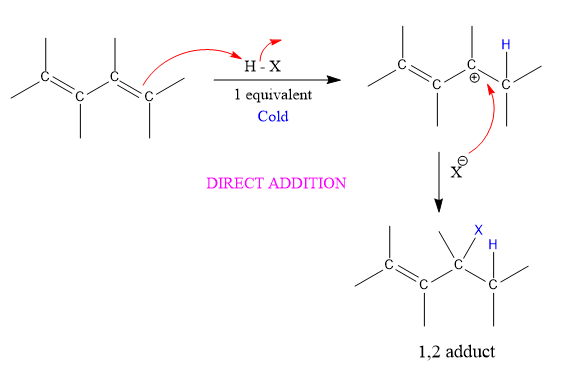Chemistry
10th Edition
ISBN:9781305957404
Author:Steven S. Zumdahl, Susan A. Zumdahl, Donald J. DeCoste
Publisher:Steven S. Zumdahl, Susan A. Zumdahl, Donald J. DeCoste
Chapter1: Chemical Foundations
Section: Chapter Questions
Problem 1RQ: Define and explain the differences between the following terms. a. law and theory b. theory and...
Related questions
Question
What is the mechanism to get from the reactant to the products

Transcribed Image Text:**Functional Group Transformations**
**Starting Compound Class:**
- Conjugated diene
**Typical Reagents and Reaction Conditions:**
1. **Reaction 7:**
- Reagent: HX (1 equivalent), cold conditions
- Reaction Outcome: 1,2-Adduct
- Diagram Description: The diagram illustrates a conjugated diene with a sequence of double bonds. When reacted with HX under cold conditions, the HX adds across the first double bond, resulting in a 1,2-adduct with H and X substituents added to the carbons involved in the initial double bond.
2. **Reaction 8:**
- Reagent: HX (1 equivalent), warm conditions
- Reaction Outcome: 1,4-Adduct
- Diagram Description: The diagram shows the same starting conjugated diene. Under warm conditions, the reaction with HX leads to the formation of a 1,4-adduct, where H and X are added to the terminal carbons of the conjugated system, spanning the entire diene.
**Compound Class Formed:**
- The reactions lead to the formation of different adducts depending on the conditions, demonstrating regioselectivity in electrophilic addition reactions with conjugated dienes.
Expert Solution
Introduction
Addition of HX to conjugated alkenes occurs via two modes:
- Direct addition (1,2 addition): HX adds directly across the ends of a C=C bond.
- Conjugate addition (1,4 addition): HX adds across the ends of conjugated system.
The distribution of the products depends on the reaction conditions (temperature).
1,2 adduct
At low temperature, the reaction is under Kinetic control (rate, irreversible conditions) and the major product is that from fastest reaction, that of the bromide with the secondary cation.

Step by step
Solved in 3 steps with 2 images

Knowledge Booster
Learn more about
Need a deep-dive on the concept behind this application? Look no further. Learn more about this topic, chemistry and related others by exploring similar questions and additional content below.Recommended textbooks for you

Chemistry
Chemistry
ISBN:
9781305957404
Author:
Steven S. Zumdahl, Susan A. Zumdahl, Donald J. DeCoste
Publisher:
Cengage Learning

Chemistry
Chemistry
ISBN:
9781259911156
Author:
Raymond Chang Dr., Jason Overby Professor
Publisher:
McGraw-Hill Education

Principles of Instrumental Analysis
Chemistry
ISBN:
9781305577213
Author:
Douglas A. Skoog, F. James Holler, Stanley R. Crouch
Publisher:
Cengage Learning

Chemistry
Chemistry
ISBN:
9781305957404
Author:
Steven S. Zumdahl, Susan A. Zumdahl, Donald J. DeCoste
Publisher:
Cengage Learning

Chemistry
Chemistry
ISBN:
9781259911156
Author:
Raymond Chang Dr., Jason Overby Professor
Publisher:
McGraw-Hill Education

Principles of Instrumental Analysis
Chemistry
ISBN:
9781305577213
Author:
Douglas A. Skoog, F. James Holler, Stanley R. Crouch
Publisher:
Cengage Learning

Organic Chemistry
Chemistry
ISBN:
9780078021558
Author:
Janice Gorzynski Smith Dr.
Publisher:
McGraw-Hill Education

Chemistry: Principles and Reactions
Chemistry
ISBN:
9781305079373
Author:
William L. Masterton, Cecile N. Hurley
Publisher:
Cengage Learning

Elementary Principles of Chemical Processes, Bind…
Chemistry
ISBN:
9781118431221
Author:
Richard M. Felder, Ronald W. Rousseau, Lisa G. Bullard
Publisher:
WILEY